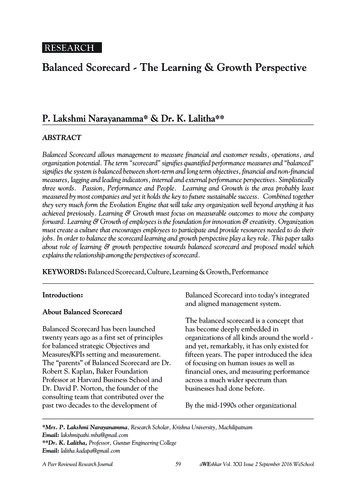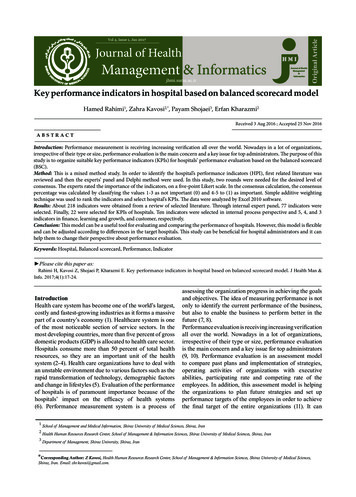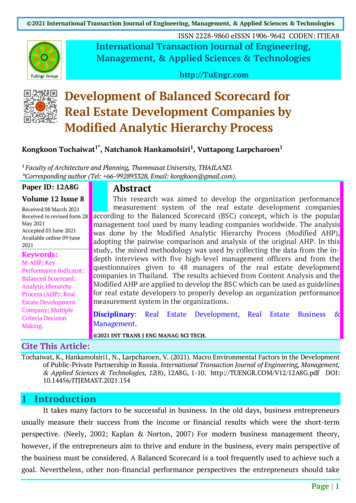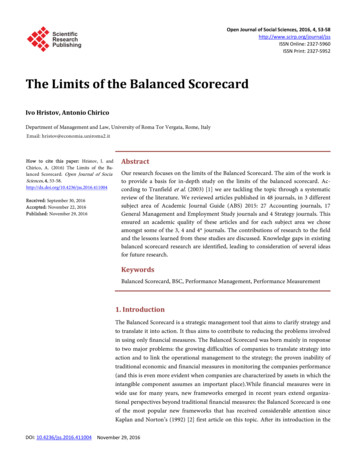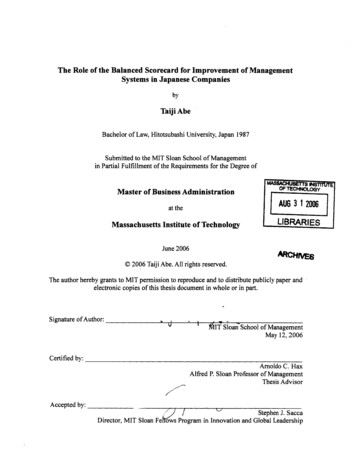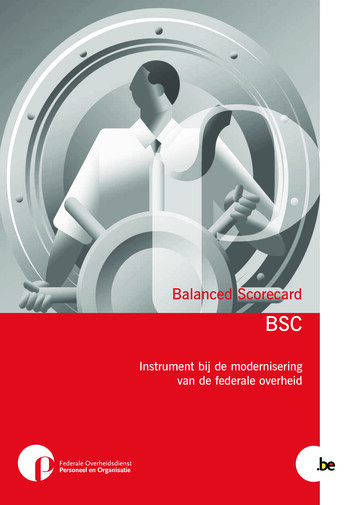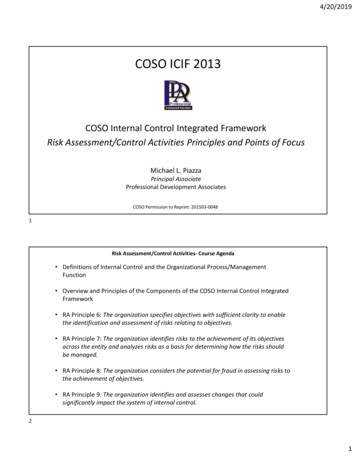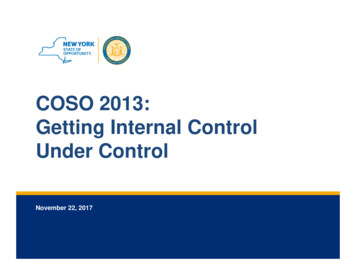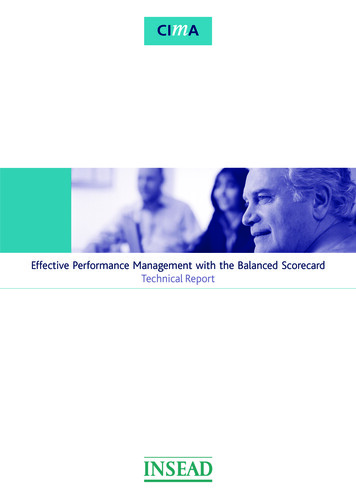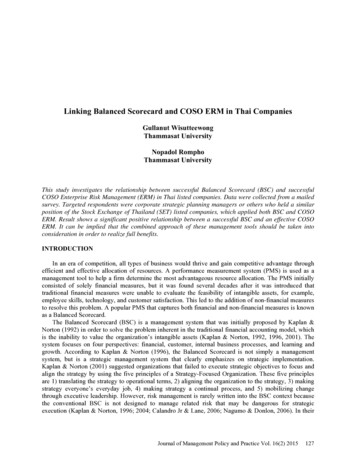
Transcription
Linking Balanced Scorecard and COSO ERM in Thai CompaniesGullanut WisutteewongThammasat UniversityNopadol RomphoThammasat UniversityThis study investigates the relationship between successful Balanced Scorecard (BSC) and successfulCOSO Enterprise Risk Management (ERM) in Thai listed companies. Data were collected from a mailedsurvey. Targeted respondents were corporate strategic planning managers or others who held a similarposition of the Stock Exchange of Thailand (SET) listed companies, which applied both BSC and COSOERM. Result shows a significant positive relationship between a successful BSC and an effective COSOERM. It can be implied that the combined approach of these management tools should be taken intoconsideration in order to realize full benefits.INTRODUCTIONIn an era of competition, all types of business would thrive and gain competitive advantage throughefficient and effective allocation of resources. A performance measurement system (PMS) is used as amanagement tool to help a firm determine the most advantageous resource allocation. The PMS initiallyconsisted of solely financial measures, but it was found several decades after it was introduced thattraditional financial measures were unable to evaluate the feasibility of intangible assets, for example,employee skills, technology, and customer satisfaction. This led to the addition of non-financial measuresto resolve this problem. A popular PMS that captures both financial and non-financial measures is knownas a Balanced Scorecard.The Balanced Scorecard (BSC) is a management system that was initially proposed by Kaplan &Norton (1992) in order to solve the problem inherent in the traditional financial accounting model, whichis the inability to value the organization’s intangible assets (Kaplan & Norton, 1992, 1996, 2001). Thesystem focuses on four perspectives: financial, customer, internal business processes, and learning andgrowth. According to Kaplan & Norton (1996), the Balanced Scorecard is not simply a managementsystem, but is a strategic management system that clearly emphasizes on strategic implementation.Kaplan & Norton (2001) suggested organizations that failed to execute strategic objectives to focus andalign the strategy by using the five principles of a Strategy-Focused Organization. These five principlesare 1) translating the strategy to operational terms, 2) aligning the organization to the strategy, 3) makingstrategy everyone’s everyday job, 4) making strategy a continual process, and 5) mobilizing changethrough executive leadership. However, risk management is rarely written into the BSC context becausethe conventional BSC is not designed to manage related risk that may be dangerous for strategicexecution (Kaplan & Norton, 1996; 2004; Calandro Jr & Lane, 2006; Nagumo & Donlon, 2006). In theirJournal of Management Policy and Practice Vol. 16(2) 2015127
view, a conventional BSC without risk management cannot be the best choice for retaining and enhancingshareholder value in the ever-changing business environment.Running a business in a changing and complex operating environment involves riskier decisionmaking that might lose long-term value for a short-term profit. A better way to retain shareholder value isintegrating the BSC with appropriate risk management mechanism as introduced by the Committee ofSponsoring Organizations of the Treadway Commission (COSO). Many researchers (for example,Beasley et al., 2006; Calandro Jr & Lane, 2006; Nagumo & Donlon, 2006; Shenkir & Walker, 2006) alsofound that core elements of COSO Enterprise Risk Management (COSO ERM) - Integrated Frameworkare strategy and risk, which are focused and aligned across the entity. Thus, it is possible to state that anintegrated approach is the better choice for businesses that intend to thrive in a changing world economy.This study focuses on the relationship between a successful BSC and an effective COSO ERM Integrated Framework. The objectives of the study are 1) to examine the success of BSC implementationas measured by best-practice standards of the Strategy-Focused Organization, 2) to examine an effectiveenterprise risk management using eight components of COSO ERM (internal environment, objectivesetting, event identification, risk assessment, risk response, control activities, information andcommunication, and monitoring) as criteria, and 3) to examine the relationship between a successful BSCimplementation and an effective COSO ERM system.LITERATURE REVIEWThe Five Principles of the Strategy-Focused OrganizationKaplan & Norton (1992) constructed a BSC for the reason that financial measures do not capture theintangible assets in long-term value creation. The BSC classifies financial performance as a laggingindicator, which is improved by three leading indicators: customer; internal business process; and learningand growth. Four perspectives of the BSC framework are linked in a cause-and-effect relationship, andare used as an operational measurement system and as a strategic management system. In the role ofstrategic management system, the BSC communicates the company’s strategy in a chain of cause-andeffect relationship. Moreover, it can be used to manage strategy over the long run by achieving fourcritical management processes, which are 1) clarifying and translating vision and strategy, 2)communicating and linking strategic objectives and measures, 3) planning, setting target and aligningstrategic initiatives, and 4) enhancing strategic feedback and learning (Kaplan and Norton, 1996). TheBSC implemented in the strategic management system starts at the top where the leaders establish a senseof urgency. The executive team uses the BSC, as a communication device, to mobilize strategicimplementation project to all employees and business units. While the executives were launching anexplicit transition between management system and strategic management system, the governance processmust have been set. This transition governance is composed of the creation of strategy teams, town hallmeetings, and open communication. During the change process, the executives develop their currentmanagement system to become a strategic management system.According to Kaplan & Norton (2001), successful companies that use a BSC approach practiced thefive principles of the strategy-focused organization to accomplish their strategic focus and alignment. Thefive principles are 1) translating the strategy to operational terms, 2) aligning the organization to thestrategy, 3) making strategy everyone’s everyday job, 4) making strategy a continual process, and 5)mobilizing change through executive leadership. These principles are fundamental in the effectiveimplementation of the BSC, which could be derived into a communication tool, a framework, and asupporting process. Additionally, the ownership and active involvement of the executives are extremelyimportant for a successful BSC implementation.The COSO ERM FrameworkIn 1996, Kaplan & Norton noted that “In general, risk management is an overlay, an additionalobjective that should complement whatever expected return strategy the business unit has chosen.” Risk isa possibility of loss, which is classified into three types: financial risk; operating risk; and technological128Journal of Management Policy and Practice Vol. 16(2) 2015
risk (Kaplan & Norton, 2004). Furthermore, the definition of risk within the BSC context could be “thedeterrent factors and uncertainties inherent in achieving the strategic objectives as defined in the BSC andthe potential losses that may result through their implementation” (Nagumo & Donlon, 2006; Shenkir &Walker, 2006). The strategic and operational failures are the risks that have an effect on the shareholdervalue (Shenkir & Walker, 2006). Risk is also presented as an unsuccessful strategic implementation orexecution resulting from either unintentional or intentional reasons (Calandro Jr & Lane, 2006). In viewof Beasley et al. (2006), risks are the events threatening an enterprise through its supply chain.According to the definitions of risk mentioned above, it could be stated that organization’s goal couldnot be fully achieved due to the existence of risks that has not yet been managed. The implementation ofBSC without appropriate risk management is extremely dangerous, for example, stretch target settingthrough BSC might create a risky behavior leading to long-term value loss. On the other hand, riskmanagement framework that does not clearly focus on corporate strategic objectives could be anunproductive system, because key risks affecting an entity do not receive proper attention from riskowners and are not efficiently mitigated. Consequently, BSC and appropriate risk management must beintegrated to ensure that shareholder value is protected.The integrated approach takes the relationship between strategy and risk management intoconsideration. Meanwhile, the risk management system that focuses on aligning strategy and risk acrossthe entity is the Committee of Sponsoring Organizations’ Enterprise Risk Management (COSO ERM)framework.COSO (2004) defined Enterprise Risk Management (ERM) as “a process, affected by an entity’sboard of directors, management and other personnel, applied in strategy setting and across theenterprise, designed to identify potential events that may affect the entity, and manage risk to be within itsrisk appetite, to provide reasonable assurance regarding the achievement of entity objectives”.The definition focuses on the achievement of entity objectives. COSO ERM is composed of fourobjectives, eight interrelated components of risk management, and the organizational units. The fourentity objectives are 1) strategic, 2) operations, 3) reporting, and 4) compliance. The entity is expected toprovide reasonable assurance to the executive team regarding the achievement of these objectives. Eightcomponents of enterprise risk management are derived from the way management runs an enterprise andintegrated with the management process. These components are 1) internal environment, 2) objectivesetting, 3) event identification, 4) risk assessment, 5) risk response, 6) control activities, 7) informationand communication, and 8) monitoring.Drawing from COSO (2004), there is a relationship between the four objectives and the eightcomponents of COSO ERM. The effectively functioned eight components are the criteria for effectiveenterprise risk management as they are the key factors that enable the four objectives to be achieved. Thispaper deliberately examines an effective ERM with eight components of COSO ERM based on theliterature reviews.The Synergism Between Risk Management and Strategic ImplementationThe aforementioned issues referred to the BSC, a strategic management system that operates on acause-and-effect relationship; and COSO ERM which consists of the eight interrelated components andfour objectives. The BSC and COSO ERM could be simultaneously implemented because they sharemany elements. They are both a continuous process that is linked to the corporate strategy in order toenhance the possibility that activities of risk management and strategic execution are achieved. These twomanagement systems approach strategy and risk on a holistic perspective and require strong support fromexecutives for managing all organizational units within a single corporate entity. Importantly, thesignificant shared element between the BSC and COSO ERM is that all employees understand andconduct their daily jobs in a way that contributes to the achievement of the entity’s objectives (Beasley etal., 2006). Clearly, there are various commonalities between BSC and COSO ERM; however thesemanagement mechanisms will not work properly if risk management is not linked to the BSC context.Nagumo & Donlon (2006) clarified that 1) using Key Performance Indicators (KPIs) in terms of Key RiskIndicators (KRIs), 2) risk management project, 3) risk management strategic theme, and 4) implementingJournal of Management Policy and Practice Vol. 16(2) 2015129
risk management in the BSC framework, are the limitations of using risk management in separation fromthe BSC.Executing risk management as a distinct objective is not a good choice for protecting shareholdervalue, thus, integrating the BSC and COSO ERM framework is the development of strategic managementsystem and risk management to achieve ultimate goal.To integrate risk management to BSC, Nagumo & Donlon (2006) starts with installing riskmanagement sub-themes for each of the internal process strategy themes, and employing the corporatestrategic objectives for the implementation of risk response approach. The second step is clarifying keyfinancial impact on the cause-and-effect relationships by setting up “Optimize Risk/Return” strategicobjective in the financial perspective, linking the interrelated components of COSO ERM to fourperspectives of the BSC, and identifying Key Performance Indicators (KPIs) in a Key Risk Indicators(KRIs) manner to enhance risk awareness throughout the entity. Additionally, Damelincourt (2013) foundthat traditional KPIs without risk management are inefficient, because risks lurking in strategic objectivesare not professionally mitigated. Hence, KPIs have to be modified by taking risk management intoconsideration.Nagumo & Donlon (2006) also illustrated risk-adjusted KPIs on each perspectives of the BSC, forexample, 1) Risk Adjusted Return on Capital (RAROC) could be used to evaluate risk that is related tolong-term shareholder value in the financial perspective; 2) Brand indicators could be utilized to assessuncertain events threatening corporate reputation in the customer perspective; 3) KPIs, in the internalprocess perspective, are metrics of the status that served as a measure of risk control activities; and 4)KPIs, in the learning and growth perspective, are designed to test human; information; and organizationcapital for implementing risk control.Furthermore, the benefits of using risk-adjusted KPIs are that 1) risk events affecting the organizationare mitigated on a strategic basis; 2) the enterprise has more accurate and more realistic indicators; and 3)it heightens management and the board of directors risk awareness (Damelincourt, 2013). In the final stepof installing integrated approach, making strategy and risk everyone’s everyday job through cascading theentity’s objectives to organizational units and all employees. When individuals have conducted their dailytask in a way which contributes to the success of the entity’s objectives, the evaluation method starts.Nagumo and Donlon (2006) suggested that in COSO ERM – integrated BSC evaluation procedure,harmful strategic activities should be carefully appraised. The harmful strategic activities might obtain anunsatisfied evaluation result because an instant financial success of those dangerous activities leads tomedium- and long-term potential risks.Another good example of an integrated approach is a study done by Beasley et al. 2006, whichpresents the linkage between COSO ERM and BSC for supply chain management. In terms of thelearning and growth perspective, objectives and measures related to learning about risk managementcould be created to increase recognition of risk to the employees. In the internal business process, goalsrelated to risk appetite or risk tolerance and risk performance metrics could be applied into thisperspective to reduce impact threats to business process. Regarding customer satisfaction, risk goals andmetrics related to customers; markets; and corporate reputation could be applied into this perspective,whereas the financial performance uses ERM cost/benefit analysis to link with this perspective (Beasleyet. al., 2006).Ballou et. al. (2006) proposed the matrix of COSO ERM – integrated BSC methodology to expandthe executives’ understanding of risk categories affecting an entity, and to successfully manage thosetypes of risks through COSO ERM framework. This matrix is composed of BSC perspectives displayingin rows and COSO ERM framework risk categories in columns. Each cell of the matrix could contain oneor more measures that are created in association with each category of risks. All sixteen cells areevaluated and determined by senior management and the board of directors.Furthermore, a study of Ballou et. al., (2006) gave an explicit example of Wal-Mart COSO ERM –integrated BSC matrics. Four measures are used to briefly explain BSC perspectives and COSO ERM riskcategories. These four measures are 1) number of new private-label product innovations, 2) average salaryand benefits at each level for gender and race, 3) number of brands available for a product, and 4) external130Journal of Management Policy and Practice Vol. 16(2) 2015
auditor fees. Firstly, in the learning and growth perspective, number of new private-label productinnovations that involves effective research and development of product lines is used to test aneffectiveness of strategic risk management. Secondly, in the business process perspective, average salaryand benefits at each level for gender and race evaluates a fairness of compensation and benefits forparticular minority group classified as a compliance risk. Thirdly, in the customer perspective, Wal-Martapplied a number of brands available for a product as a metric to assess operation risk related to customerdissatisfaction with organizational supply chain management.Finally, in the financial perspective, external auditor fees are used to measure reporting risk. Ballouet. al., (2006) recommended Wal-Mart to present external auditor fees at a reasonable level by comparingthe fees to its stakeholders’ expectations and other public companies. The study emphasized on theconnection between BSC concept and COSO ERM framework. This COSO ERM – integrated BSCframework would be useful to an enterprise as it provides better understanding of risks-related corporatestrategic objectives.An objective of COSO ERM – integrated BSC approach is to execute strategy within the limit ofcorporate risk appetite that results in creating long-term shareholder value. Additionally, risk managementprovides feedback for strategic implementation by identifying key risks on each perspective of the BSC.Those key risks are prioritized on the basis of likelihood and impact, including the consideration of theimportance of strategy (Nagumo & Donlon, 2006). Hence, it is possible to understand that the BSC andCOSO ERM develop and complement each other.RESEARCH METHODOLOGYThis study examines the relationship between a success on BSC and an effective COSO ERM. Datawere collected from a mailed survey. The investigation is limited to the 93 companies which are listed inthe Stock Exchange of Thailand (SET) that implement both BSC and COSO ERM. Targeted respondentsare corporate strategic planning manager or others who held a similar position of each sample company.They were asked to participate in answering a questionnaire on the evaluation of the success on BSC andan effective COSO ERM of Thai listed companies. Five-point Likert’s scale was used where 1 meansleast successful and 5 means most successful. The success of BSC was measured for each of thecomponents in strategy-focused organization, namely translating the strategy to operational terms,aligning the organization to the strategy, making strategy everyone’s everyday job , making strategy acontinual process , and mobilizing change through executive leadership. On the other hand, the success ofCOSO ERM was measured for each of the component in effective ERM, namely internal environment,objective setting, event identification, risk assessment, risk response, control activities, information andcommunication, and monitoring. A questionnaire that is packaged in a postage-paid and self-addressedenvelope is mailed out to each targeted respondents in February 2013. After data was collected, structuralequation modeling (SEM) technique was used.FINDINGS AND RESULTS124 questionnaires were finally returned but only 93 responses were usable because some companiesdid not employ either BSC or COSO ERM or failed to complete the questionnaire. Therefore, the usableresponse rate is 75 percent. Around 52 percent of respondents are male, 72 percent graduated the Master’sdegree, 47 percent are in the middle manager position, and 17 percent are in the property and constructionindustry. TABLE 1 presents the industry of companies participating the survey, overall mean score, andspecific score of successful BSC and effective COSO ERM for each industry.Journal of Management Policy and Practice Vol. 16(2) 2015131
TechnologyMAI16Service14Property uctsAgribusiness andFoodMean scores by industry classificationIndustrialNumber of participatingcompaniesSuccessful BSCimplementationTranslating theSFOstrategy to1operational termsAligning theSFOorganization to the2strategyMaking strategySFOeveryone’s everyday3jobSFO Making strategy a4continual processMobilizing changeSFOthrough executive5leadershipAverageOverall standarddeviationFactors of successOverall meanTABLE 1INDUSTRY OF COMPANIES PARTICIPATING THE SURVEY AND MEAN SCORE OFSUCCESSFUL BSC AND EFFECTIVE COSO ERM1117453.64 1.021 3.50 3.75 3.43 3.64 4.00 4.00 3.33 4.50 3.333.36 0.978 2.50 3.25 3.21 3.79 3.43 3.56 3.13 3.92 3.223.34 0.908 3.10 3.47 3.20 3.54 3.68 3.68 3.05 3.50 2.933.35 1.015 2.94 2.96 3.20 3.86 3.78 3.61 3.11 3.38 2.883.45 0.956 2.50 3.00 3.33 4.00 3.80 3.58 3.39 4.00 2.672.91 3.29 3.27 3.77 3.74 3.69 3.20 3.86 3.01Effective ERMERMInternal environment1ERMObjective setting2ERMEvent identification3ERMRisk assessment4ERMRisk response5ERMControl activities6ERM Information and7communicationERMMonitoring8Average1322.78 0.930 2.67 3.06 2.33 3.14 2.87 3.21 2.44 3.50 2.333.63 0.791 3.00 3.71 3.61 4.11 3.85 4.19 3.33 4.50 3.333.11 0.834 3.00 3.42 2.93 3.71 3.00 3.25 2.50 4.00 3.673.55 0.862 3.00 3.83 3.43 4.14 3.60 3.75 3.08 4.50 4.003.61 0.767 3.00 3.92 3.29 4.07 3.70 3.63 3.25 4.50 3.833.49 0.888 3.00 3.83 3.21 4.14 3.80 3.38 3.04 5.00 3.503.66 0.943 3.00 3.58 3.50 4.07 3.60 4.25 3.21 5.00 3.673.61 0.977 2.80 3.43 3.20 4.14 3.72 3.90 3.12 4.90 4.072.93 3.63.19 3.94 3.52 3.7Journal of Management Policy and Practice Vol. 16(2) 20153.00 4.49 3.55
The conceptual model illustrated in FIGURE 1 was examined by using Structural Equation Modeling(SEM) technique. The values of CMIN/DF 1.316, GFI 0.825, NFI 0.861 and RMSEA 0.079 (withp-value 0.171) indicate that the Final Model in FIGURE 1 acceptably fits with the data.FIGURE 1FINAL RESEARCH UL BSC0.260.87EFFECTIVE 8E13In FIGURE 1, Ei refers to error of measurement for each variable, whereas the numbers that areshown in the Final Model are standardized relationship between each variable.The variables of the successful BSC implementation (SUCCESSFUL BSC) are organized into fivecategories as presented in the principles of strategy-focused organization: SFO1, SFO2, SFO3, SFO4, andSFO5. The findings of SEM technique present strong relationships between all components of thestrategy-focused organization and successful BSC implementation variables. The results show positiverelationship between effective ERM (EFFECTIVE ERM) and eight interrelated components of COSOERM framework.As mentioned in the objectives of this paper, a success on BSC is supposed to be positively relatedwith an effective ERM. The result of Final Model analysis indicates that a significant positive relationshipbetween a successful BSC and an effective COSO ERM is found (standardized relationship 0.76 with pvalue 0.001). In other words, this finding illustrates that there are commonalities between BSC andCOSO ERM as discussed in the theoretical explanations of BSC - COSO ERM linkage.CONCLUSION AND RECOMMENDATIONSThe purpose of this research is to investigate the relationship between BSC and COSO ERM in Thailisted companies, for the reason that the conventional BSC, which does not include risk management,Journal of Management Policy and Practice Vol. 16(2) 2015133
might risk the deterioration of shareholder value. Consequently, BSC should be developed by integratingrisk management into the framework.In this paper, successful BSC implementation is referred to the application of the BSC as a strategicmanagement system, which is measured by principles of the strategy-focused organization. Furthermore,the effective ERM is that the eight components of COSO ERM are appropriately functioned.The finding on the connection between successful BSC implementation and effective ERM presentedsignificant positive relationship (standardized regression weight 0.76 with p-value 0.001).The COSO ERM – integrated BSC approach helps executing strategy within the level of risk appetitethat results in creating long-term shareholder value. If the company invests in a new high-risk project toreceive high return, the early warning process of risk management will be managed to identify an adverseevent that might be dangerous to the achievement of corporate strategy. The relationship between BSCand COSO ERM that is found in this study also extends prior studies related to the BSC – integratedCOSO ERM (for example, Ballou et. al., 2006; Beasley et. al., 2006; Calandro Jr & Lane, 2006; Nagumo& Donlon, 2006; Shenkir & Walker, 2006; Woods, 2008). Furthermore, this study presents amethodology in which both systems can be simultaneously implemented as the success or failure of onesystem could impact the success or failure of the other system.As the integrated approach is proposed for preserving long-term shareholder value, this studyanticipates the increasing trend of adopting BSC – integrated COSO ERM. The combined approach ofthese management tools is one of the aspects that should be taken in consideration when improving BSCframework, which in this case, is by adding risk management to the cause-and-effect relationship of thestrategy map.Nevertheless, the sample size (93 responding companies) of this research is not very large, the resultsmust be carefully interpreted. The generalization of the result might also be limited. Future research mayreplicate this paper using a larger sample size. The relationship between successful BSC with effectiveERM and financial performance of firms can also be studied.REFERENCESBallou, B., Brewer, P.C. & Heitger, D.L. (2006). Integrating the Balanced Scorecard and Enterprise RiskManagement, Internal Auditing, 21, (3), 34-38.Beasley, M., Nunez, K. & Wright, L. (2006). Working hand in hand: Balanced Scorecard and EnterpriseRisk Management, Strategic finance, 49-55.Calandro, J. & Lane, S. (2006). An introduction to the Enterprise Risk Scorecard, Measuring BusinessExcellence, 10, 31-40.Damelincourt, A. (2013). Turn KRIs and KPIs into Risk-Adjusted Performance Indicators, MEGAInternationalKaplan, R.S. & Norton, D.P. (1992). The Balanced Scorecard: measures that drive performance, HarvardBusiness Review, 70, September-October, 71-89.Kaplan, R.S. & Norton, D.P. (1996). The Balanced Scorecard: Translating Strategy into Action, HarvardBusiness School Press, Boston.Kaplan, R.S. & Norton, D.P. (2001). The Strategy-Focused Organization, Harvard Business SchoolPress, Boston.Kaplan, R.S. & Norton, D.P. (2004). Strategy Maps, Harvard Business School Press, Boston.Nagumo, T. & Donlon, B.S. (2006). Integrating the Balanced Scorecard and COSO ERM frameworks,Cost Management, 20,(4), 20-30.Shenkir, W.G. and Walker, P.L. (2006). Enterprise Risk Management and the Strategy-Risk-FocusedOrganization, Cost Management, 20, (3), 32-38.Woods, M. (2008). Linking risk management to strategic controls: a case study of Tesco plc, TheInternational Journal of Risk Assessment and Management, 7, (8), 1074-1088.134Journal of Management Policy and Practice Vol. 16(2) 2015
The COSO ERM Framework In 1996, Kaplan & Norton noted that "In general, risk management is an overlay, an additional . (2013) found that traditional KPIs without risk management are inefficient, because risks lurking in strategic objectives are not professionally mitigated. Hence, KPIs have to be modified by taking risk management into .
